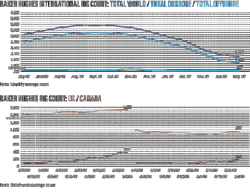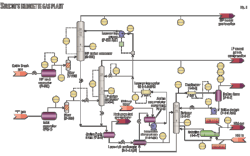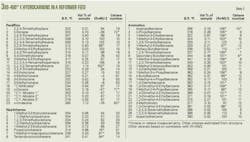The Baltic Sea region's role on Europe's energy map will grow in the near future. The Baltic accounts for more than 15% of global cargo transportation.1
But it is also a fragile environment. It is a shallow (average depth 50 m compared with 1,300 m for the Black Sea and 1,500 m for the Mediterranean) and almost closed body of water; only 3% of its water is exchanged each year with the neighboring North Sea.2
Faced with the growing use of the sea as a transit route and accompanying logistical difficulties, the EU has adopted a more coherent strategic approach for the region than it did for the similar transportation bottleneck in the Black Sea region. This article examines the recent evolution of oil and gas shipment in the Baltic region before discussing measures currently being considered by the EU to implement critical gas infrastructure projects proposed by the Baltic Energy Market Interconnection Plan among other initiatives.
Pursuing these initiatives is especially important during periods of economic crisis or slowdown when it's easier to put projects on hold, despite their long-term strategic importance. The EU should develop a regional energy dialogue with the main oil and gas supplier in the Baltic Sea region, the Russian Federation, by including it in the implementation of its Baltic Sea regional strategy. A regional EU-Russia energy dialogue forum would allow the parties better to address future developments in regional oil and gas transportation.
Energy trends
The opening by the Russian Federation of new oil export markets around the world and the diversion of some of the oil previously exported through the Druzhba system to the Baltic port of Primorsk increased oil traffic in the Gulf of Finland—the eastern part of the Baltic Sea—by 400% between 1995 and 2005.2 In 2007, 170 million tonnes of oil moved through the Baltic Sea compared with 80 million tonnes in 2000.1
In 2001 Transneft completed the Baltic Pipeline System (BTS), aimed at exporting oil directly from the Russian Baltic port of Primorsk instead of transiting and reexporting it through other countries such as Belarus, Lithuania, or Latvia. The BTS pipeline reached its 65-million tonne/year (tpy) design capacity in 2006.
Oil tanker transit pressure in the Baltic Sea will only increase in the near future, given the June 2009 beginning of construction of the 50-75 million tpy Baltic Pipeline System 2 (BTS 2).1 The pipeline will transport oil to the Baltic export terminal in Ust-Luga and to the Kirishi refinery (Fig. 1). When BTS 2 reaches design capacity in September 2013 it could increase Baltic Sea oil transit to 200-220 million tpy.
Another project, supported mainly by Ukraine and Poland, would expand the Odessa-Brody pipeline through Plock to the Baltic port of Gdansk, Poland, to bring oil from the Black Sea. This project, if successful, could add another 10-20 million tpy to Baltic Sea oil tanker transit.
The European Union already considers the Baltic Sea an oil transportation chokepoint similar to more famous bottlenecks such as the Strait of Hormuz, the Suez Canal, or the Strait of Malacca. The busy oil tanker transit creates environmental risks for the region, the Baltic already suffering 120 ship accidents in 2007.2
The Baltic Sea is poised also to become a major natural gas transit region. Nord Stream, a double 1,220-km gas pipeline, will be the first major natural gas pipeline to cross the Baltic Sea and bring Russian gas to the Germany and other European markets.
The first line, with a capacity of 27.5 billion cu m/year is planned for completion in 2011, while the second pipeline, double capacity to 55 billion cu m/year would become operational in 2012 (Fig. 2).
Other international gas pipeline projects crossing the Baltic Sea are in different stages of planning, including the BalticPipe (Denmark to Poland) and Baltic Connector (Finland-Estonia) pipelines, and no less than five LNG terminals in Finland, Estonia, Latvia, Lithuania, and Poland.3
The amount of coordination and cooperation needed during the planning of the first phase of the Nord Stream project due to its political, legal and, environmental complexity highlights the problems faced by future similar pipeline projects in the region. A recent European Union study stated that eventual LNG shipping in the Baltic Sea remains legally uncertain. The study also concluded LNG shipping in the Baltic Sea would increase bottlenecks for an already busy shipping region.4
The natural gas consumption of most Baltic countries—with the notable exception of Sweden, which wants to move away from all fossil fuels—has increased and is forecast to continue to growing, especially given the EU's strong policy agenda promoting the use of natural gas as a relatively less polluting fossil fuel than oil or coal. Natural gas consumption in Poland, as an example, is forecast to increase to around 20-22 billion cu m/year in 2030 from current levels around 13-15 billion cu m/year.5
The EU has also strongly supported liberalization and opening of national gas markets to create EU-wide energy markets instead. Its policy efforts, however, are less advanced in the oil market and oil transportation. The historical development of their oil and gas transportation networks has kept Finland, Estonia, Latvia, and Lithuania essentially isolated from the wider EU oil and gas transportation systems,2 limiting liberalization and creating supply and price risks.
EU strategy
As early as the 1990s, the EU moved to address some of its infrastructural shortcomings through regional initiatives and action plans, as well as through three internal energy market legislative packages. These early initiatives included Baltic 21, a regional process for creating sustainable development in the region through cooperation among different stakeholder categories; Basrec—the Baltic Sea Region Energy Cooperation; and Baltrel, the Baltic Ring Electricity Cooperation Committee.6 Each sought a regional gas market, the diversification of gas supply sources, and common measures of supply security.
The first energy market legislative package, the Gas Directive of 1998, asked EU countries to partially open gas markets to competition by allowing large users to choose their suppliers in an effort to avoid any discrimination by national gas monopolies.
The second Gas Directive in 2003 required each country to create a transmission system operator (TSO) in charge of operating, maintaining, and developing the national gas transmission pipeline network. By July 2007 all gas customers were able to choose their gas supplier.
The third legislative package, the Internal Energy Market package, approved in 2009, contains a directive on the common internal market for natural gas and regulation of conditions for access to the natural gas transmission networks,7 pushing liberalization of the national gas markets further toward the creation of an EU-wide market.
The European Council invited the EU Commission in 2007 to present an EU strategy for the Baltic Sea region, approved in June 2009, marking the first time the EU has adopted this type of strategic approach. One of the main action plans of the new regional strategy is the Baltic Energy Market Interconnection Plan.3 This plan focuses on both the power and gas sectors, its main objectives for the gas sector being to support projects connecting the Baltic energy markets to EU markets, increase the security of supply, and diversify supply sources.
Specific objectives for gas infrastructure development are:
• Ending the energy isolation and decrease dependence on a single external gas supplier of Finland, Estonia, Latvia, Lithuania, and Poland.
• Defining and strengthening Poland's role as an energy bridge to the other countries. Supply to Poland from Germany, Denmark, or LNG is necessary to move it further to eastern Baltic Sea nations.
• Assessing LNG's potential for diversifying supply sources in the Baltic Sea region.
• Compensating for the decline in the Danish gas reserves and providing new gas sources to Denmark and Poland, through new infrastructure projects in the West Baltic Sea region.3
The Ramboll report, delivered in preparation for the EU Strategy for the Baltic Sea Region meetings, identified several missing links in the regional gas infrastructure, including the following:
• Finland to another EU member state. With plans for establishing a gas network in Sweden halted, however, the only short-term solution seems to be a connection to Estonia such as the Baltic Connector.
• Estonia, Latvia, or Lithuania to one of the member states already interconnected to the other EU markets, Poland or Germany.
• Norway to Denmark or Norway to Sweden, diversifying gas supply with Norwegian imports.
• Denmark to Poland.
• Germany to Sweden.8
The solutions proposed include new pipelines (see table), a number of which were put on hold due to the effects of the global economic crisis on gas demand and potential financing. Skanled, for instance, which would have brought Norwegian gas to the Baltic was suspended in April 2009.
Proposed solutions also included increased capacity through existing pipeline interconnections; reversed flow in the existing pipelines, such as Yamal-Europe and LNG terminal in the Baltic Sea; and new gas storage projects, especially in Latvia, Lithuania, Poland, and Germany.
The European Union is also assessing measures for creating a more coherent policy framework to address present and future oil transportation problems. The Oil Infrastructures report1 recommends the EU develop an oil dimension to its energy policy instruments (currently including only electricity and gas) so it can better coordinate development of an EU-wide oil infrastructure and better manage future oil bottlenecks such as the Baltic Sea region.
The report also recommends including oil infrastructure projects in the Trans-European Networks-Energy program, providing selected projects with political support and financing. Another recommendation is to develop a more coherent EU-wide dialogue with the major oil suppliers, including Russia.
References
1. Commission of the European Communities, "Oil Infrastructures—An assessment of the existing and planned oil infrastructures within and towards the EU," Commission Staff Working Document accompanying the Green Paper—Towards a secure, sustainable and competitive European energy network, 2008.
2. Commission of the European Communities, "Communication from the Commission to the European Parliament, the Council, the European Economic and Social Committee, and Committee of the Regions concerning the European Union Strategy for the Baltic Sea Region," COM(2009) 248 final, 2009.
3. Commission of the European Communities, "Baltic Energy Market Interconnection Plan—final report of the HLG," EU Energy Directorate, 2009.
4. Clingendael International Energy Programme (CIEP), "The Geopolitics of EU Gas Supply: The role of LNG in the EU gas markets, Part IIA/DMV," The Hague, 2008.
5. Upstream Online, "Poland pushes ahead with shale plans," Jan. 27, 2010.
6. Baltic Development Forum, Energianalyse a/s, "Energy Perspectives of the Baltic Sea Region—Interim Report," 2009.
7. Havris, C., "Competition and Regulation in the EU Energy Market," Romanian Journal of European Affairs, Vol. 9, No. 4, 2009.
8. Ramboll, "Future Development of the Energy Gas Market in the Baltic Sea Region—Final Report," prepared for EU Commission DG TREN C1, June 2009.
The author
More Oil & Gas Journal Current Issue Articles
More Oil & Gas Journal Archives Issue Articles
View Oil and Gas Articles on PennEnergy.com






